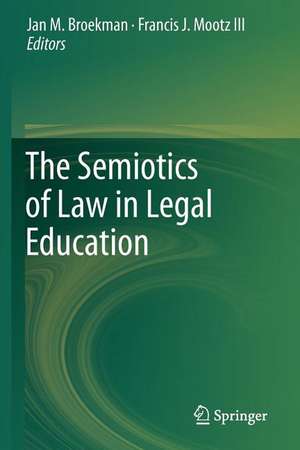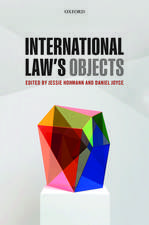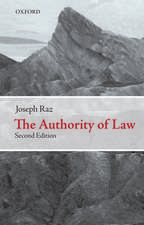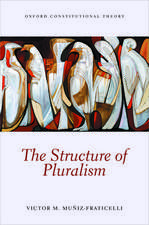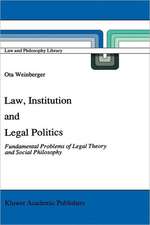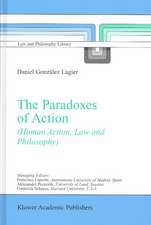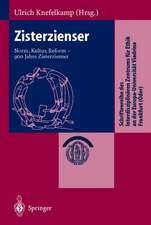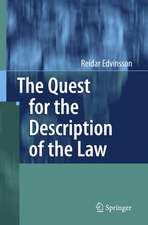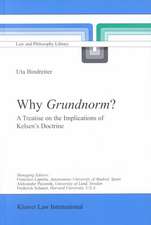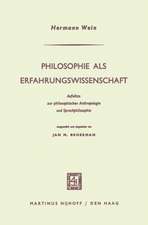The Semiotics of Law in Legal Education
Editat de Jan M. Broekman, Francis J. Mootz IIIen Limba Engleză Paperback – 15 iul 2012
| Toate formatele și edițiile | Preț | Express |
|---|---|---|
| Paperback (1) | 386.81 lei 6-8 săpt. | |
| SPRINGER NETHERLANDS – 15 iul 2012 | 386.81 lei 6-8 săpt. | |
| Hardback (1) | 390.63 lei 6-8 săpt. | |
| SPRINGER NETHERLANDS – 6 iul 2011 | 390.63 lei 6-8 săpt. |
Preț: 386.81 lei
Nou
Puncte Express: 580
Preț estimativ în valută:
74.01€ • 77.49$ • 61.24£
74.01€ • 77.49$ • 61.24£
Carte tipărită la comandă
Livrare economică 05-19 aprilie
Preluare comenzi: 021 569.72.76
Specificații
ISBN-13: 9789400753594
ISBN-10: 9400753594
Pagini: 250
Ilustrații: XVI, 255 p. 26 illus., 1 illus. in color.
Dimensiuni: 155 x 235 x 20 mm
Greutate: 0.39 kg
Ediția:2011
Editura: SPRINGER NETHERLANDS
Colecția Springer
Locul publicării:Dordrecht, Netherlands
ISBN-10: 9400753594
Pagini: 250
Ilustrații: XVI, 255 p. 26 illus., 1 illus. in color.
Dimensiuni: 155 x 235 x 20 mm
Greutate: 0.39 kg
Ediția:2011
Editura: SPRINGER NETHERLANDS
Colecția Springer
Locul publicării:Dordrecht, Netherlands
Public țintă
ResearchCuprins
Preface— Semiotics in the Seminar; Jan M. Broekman, Francis J. Mootz III, William A. Pencak: 1 Introduction.- 2 The Kevelson Round Tables.- 3 The Seminar at Penn State Law.- Part 1: Philosophical Dimensions.- Introduction. Jan M. Broekman.- Chapter 1.“Die Sache”: The Foundationless Ground of Legal Meaning. Francis J. Mootz III.- Chapter 2. Faces Face to Face. Jan M. Broekman.- Chapter 3.Tarski, Peirce and Truth-Correspondences in Law. Paul Van Fleet.- Part 2: History, Law and Semiotics.- Introduction.Jan M. Broekman.- Chapter 4. History and Semiotics: Preliminary Thoughts.William A. Pencak.- Chapter 5. Teaching Law and Semiotic-Sensitivity in the Life and Career of John Reed, Founder of the Dickinson School of Law. William E. Butler.- Chapter 6. Initiating the Two Legal Cultures of the Early United States William A. Pencak.- Part 3: Semiotics and the Legal System.- Introduction.Jan M. Broekman.- Chapter 7. Common Law Lawyers Should Mind their Trial Practices: Understanding, Identifying and Correcting a Semiotic Imbalance.Edward J. Cyran.- Chapter 8. Semiotics in Legal Theory Design. Jeffrey A.Ellsworth.- Part 4: Gender and Family.-Introduction. Francis J. Mootz III.- Chapter 9. Semiotics of Parenthood in Legal Perspective. Michelle L. Wirth.- Chapter 10. ‘Michael H. v. Gerald D’. Jeffrey A. Ellsworth.- Part 5. Economy, Business.- Introduction Francis J.Mootz III.- Chapter 11. Trademarks, A Social . Elizabeth Karnezos.- Chapter 12.Trademarks as a System of Signs. Meghann L. Garrett.- Chapter 13. The Semiotics of “Public Use”. Nathan Harvill.- About the Authors.
Textul de pe ultima copertă
This book offers educational experiences, including reflections and the resulting essays, from the Roberta Kevelson Seminar on Law and Semiotics held during 2008 – 2011 at Penn State University’s Dickinson School of Law. The texts address educational aspects of law that require attention and that also are issues in traditional jurisprudence and legal theory. The book introduces education in legal semiotics as it evolves in a legal curriculum. Specific semiotic concepts, such as “sign”, “symbol” or “legal language,” demonstrate how a lawyer’s professionally important tasks of name-giving and meaning-giving are seldom completely understood by lawyers or laypeople. These concepts require analyses of considerable depth to understand the expressiveness of these legal names and meanings, and to understand how lawyers can “say the law,” or urge such a saying correctly and effectively in the context of a natural language that is understandable to all of us. The book brings together the structure of the Seminar, its foundational philosophical problems, the specifics of legal history, and the semiotics of the legal system with specific themes such as gender, family law, and business law.
Caracteristici
First time focus on the implementation of legal semiotics on legal education Revisits many dimensions of legal practice and contributes to a uniquely sharp focus on lawyers' signifying activities Shows how a 3-credit course can bring law students to research and understanding via semiotics
